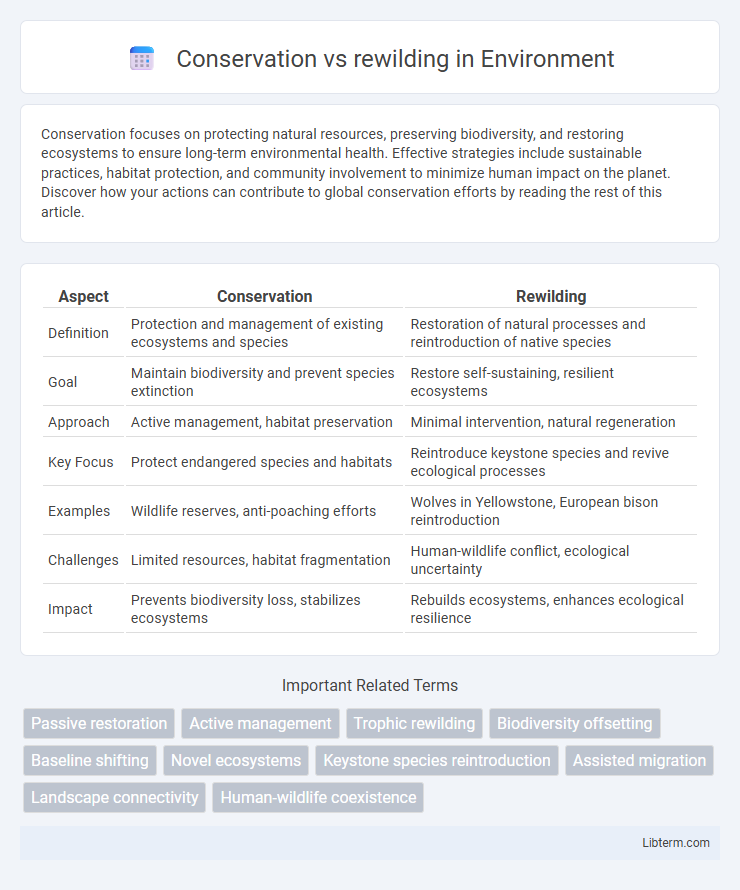Conservation focuses on protecting natural resources, preserving biodiversity, and restoring ecosystems to ensure long-term environmental health. Effective strategies include sustainable practices, habitat protection, and community involvement to minimize human impact on the planet. Discover how your actions can contribute to global conservation efforts by reading the rest of this article.
Table of Comparison
| Aspect | Conservation | Rewilding |
|---|---|---|
| Definition | Protection and management of existing ecosystems and species | Restoration of natural processes and reintroduction of native species |
| Goal | Maintain biodiversity and prevent species extinction | Restore self-sustaining, resilient ecosystems |
| Approach | Active management, habitat preservation | Minimal intervention, natural regeneration |
| Key Focus | Protect endangered species and habitats | Reintroduce keystone species and revive ecological processes |
| Examples | Wildlife reserves, anti-poaching efforts | Wolves in Yellowstone, European bison reintroduction |
| Challenges | Limited resources, habitat fragmentation | Human-wildlife conflict, ecological uncertainty |
| Impact | Prevents biodiversity loss, stabilizes ecosystems | Rebuilds ecosystems, enhances ecological resilience |
Introduction to Conservation and Rewilding
Conservation involves protecting existing natural habitats and species to maintain biodiversity and ecosystem stability. Rewilding emphasizes restoring ecosystems by reintroducing native species and allowing natural processes to shape landscapes. Both approaches aim to enhance ecological health but differ in methods and long-term goals for habitat management.
Historical Context of Conservation Efforts
Conservation efforts historically emerged in the late 19th and early 20th centuries as a response to rampant habitat destruction and species extinction driven by industrialization and colonial expansion. Early conservation prioritized protecting specific areas and species through laws, national parks, and reserves, emphasizing preservation over ecological restoration. Rewilding, a more recent concept, builds on these foundations by advocating the restoration of entire ecosystems and the reintroduction of keystone species to revive natural processes disrupted by human activity.
Understanding Rewilding: Definitions and Principles
Rewilding is an ecological restoration approach focused on restoring natural processes and wilderness areas by reintroducing native species, especially keystone predators, to promote biodiversity and ecosystem resilience. Unlike traditional conservation, which often emphasizes protecting specific species or habitats, rewilding aims to recreate self-sustaining ecosystems through minimal human intervention. Core principles include allowing natural disturbance regimes, facilitating trophic cascades, and enhancing ecological connectivity across landscapes.
Key Goals: Preservation vs Ecological Restoration
Conservation aims to preserve existing natural habitats and protect endangered species by maintaining stable ecosystems and preventing further degradation. Rewilding focuses on ecological restoration by reintroducing native species and restoring natural processes to revive biodiversity and ecosystem functions. Both approaches prioritize biodiversity but differ fundamentally in their goal: conservation emphasizes preservation, while rewilding targets ecosystem recovery and resilience.
Methods and Approaches: Fences or Freedom?
Conservation methods often rely on fences to protect endangered species by creating controlled habitats that prevent poaching and human-wildlife conflict, ensuring focused management and monitoring. Rewilding emphasizes freedom by removing physical barriers, restoring natural processes, and allowing species to roam freely, which promotes ecosystem resilience and biodiversity recovery. These contrasting approaches reflect a balance between human intervention for immediate protection and long-term ecological restoration through natural movement and behavior.
Benefits and Risks of Conservation
Conservation efforts protect biodiversity by preserving habitats and preventing species extinction, ensuring ecosystem stability and resilience against environmental changes. These practices support sustainable resource management and maintain ecosystem services vital for human wellbeing, such as water purification and climate regulation. However, conservation can sometimes lead to risks like genetic bottlenecks, limited natural species adaptation, and potential conflicts with local communities due to restricted land use.
Advantages and Challenges of Rewilding
Rewilding promotes ecosystem restoration by reintroducing native species and restoring natural processes, enhancing biodiversity and improving climate resilience. Key challenges include managing human-wildlife conflicts, securing long-term funding, and addressing ecological uncertainties in altered landscapes. Success depends on careful planning, stakeholder collaboration, and adaptive management to balance ecological goals with social and economic interests.
Case Studies: Comparing Outcomes Worldwide
Case studies from Yellowstone National Park demonstrate how rewilding with wolves restored ecological balance, boosting biodiversity and controlling elk populations. In contrast, traditional conservation efforts in the Amazon prioritize habitat protection and anti-poaching measures, effectively preserving species diversity but limiting large-scale ecosystem restoration. Comparing these outcomes highlights that rewilding often accelerates trophic cascades and ecosystem resilience, while conservation focuses on safeguarding existing habitats and species.
Community and Stakeholder Perspectives
Community involvement plays a crucial role in both conservation and rewilding efforts, with local stakeholders often advocating for resource use that supports livelihoods while maintaining ecological balance. Stakeholder perspectives vary widely, as conservation typically emphasizes protecting existing ecosystems, whereas rewilding promotes restoring natural processes, sometimes sparking concerns about land use, access, and economic impacts. Effective collaboration and transparent communication between governments, Indigenous groups, farmers, and environmental organizations are essential for aligning goals and fostering sustainable, inclusive environmental management.
The Future of Conservation and Rewilding
The future of conservation and rewilding hinges on integrating advanced ecological data and community-driven strategies to restore biodiversity and ecosystem services effectively. Innovations in genetic restoration, habitat connectivity, and adaptive management practices are pivotal in reversing species decline and promoting resilience against climate change. Emphasizing collaborative governance and funding models ensures sustainable, scalable conservation efforts that align with global biodiversity targets.
Conservation Infographic

 libterm.com
libterm.com